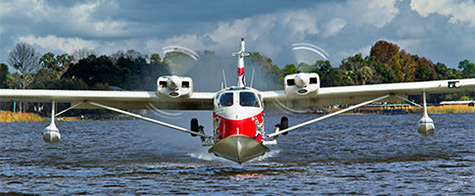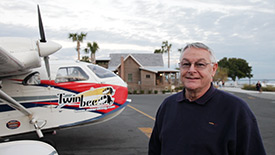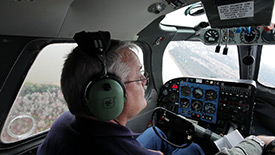Challenges: Stretch your skills by trying a new form of flight
Thunder on the water: The Twin Bee will float your boat
Alligators are terrible at walking on land. They’re slow, they waddle, and they swing their heads from side to side. Now, consider the 3,800-pound Republic/STOL-Aircraft UC–1 Twin Bee amphibious multiengine seaplane. Same thing. The Twin Bee is much happier in the air or on water than on land.
The purpose of my Twin Bee flight was to accept the challenge of flying a multiengine seaplane. I found one used for multiengine land and sea ratings at Jones Brothers and Company Air and Seaplane Adventures in Tavares, Florida, a 20-minute drive north of Orlando. (You can get both ratings in a single checkride. Scenic rides are also available in the Twin Bee and single-engine floatplanes.) I could spill a secret at this point about the Jones brothers, but I need to think about it for a few paragraphs.
I took only the first hour of a five- to seven-hour course for the multiengine seaplane rating, and am ready to confess my beginner’s mistakes before more than 400,000 readers.
You can see the aircraft I flew in the movie The Rum Diary, based on the book by the late Hunter S. Thompson. The movie, starring Johnny Depp, is due out later this year.

Goat rope
Preflight discussion included the term “goat rope” when describing how to taxi the Twin Bee on land. Landing at Florida’s Leesburg International Airport, I had little time to celebrate a smooth, well-coached crosswind landing of the tailwheel aircraft. (It turns out the Twin Bee is a docile tailwheel aircraft.) But, after the landing came the taxi.
I got off the runway and onto the taxiway, but an S turn lay ahead—and I got stuck in it. Couldn’t turn, and couldn’t proceed without leaving the taxiway. Always-patient instructor Eric Weaver had to bail me out. It required differential braking and differential power from the two 180-horsepower Lycoming IO-360 engines—and an experienced pilot. Weaver is also the pilot who operated the aircraft for The Rum Diary.
A little history
All 23 Twin Bees ever built began life between 1945 and 1947 as single-engine Seabees. Their conversions to multiengine aircraft were done 20 years later. More than 1,000 of the Franklin-powered Seabees were built by Republic Aviation Corporation between 1945, when military and civilian orders seemed promising, and 1948, when the orders fizzled. Most returning servicemen decided not to continue flying.
The single-engine seaplane was designed by a Republic Aviation test pilot and engineer with four names, Percival Hopkins “Spence” Spencer. During World War II, he made 134 test flights in newly built Republic P–47 Thunderbolts. The Twin Bee, like the P–47, is all bolts and rivets; heavy-gauge aluminum; and thick, forged parts. It’s built for warriors, not wimps. It should be no surprise that the Seabee, a name borrowed with permission from the U.S. Navy in the 1940s, began as the RC–1 Thunderbolt.
United Consultants Corporation, headed by Joseph Gigante (now in his 90s)—later named STOL Aircraft and based in Norwood, Massachusetts—did all of the Twin Bee multiengine conversions. Gigante designed the conversion, resulting in today’s designation: Republic/STOL Aircraft UC (for United Consultants)–1. That’s now the aircraft designation in my logbook for my most recent flight review.
Great instructor, big airplane
 Walking up to the 10-foot-tall Twin Bee with its 43-foot wingspan was a little intimidating, but what’s up with the boxy cabin? I wasn’t able to find an answer, but during the early design phase the Seabee was named the Spencer S–12 Air Car Amphibian. Maybe Spencer was trying to make the airplane look like a car. To save costs, a great many automobile parts were used.
Walking up to the 10-foot-tall Twin Bee with its 43-foot wingspan was a little intimidating, but what’s up with the boxy cabin? I wasn’t able to find an answer, but during the early design phase the Seabee was named the Spencer S–12 Air Car Amphibian. Maybe Spencer was trying to make the airplane look like a car. To save costs, a great many automobile parts were used.
Before my flight there was a two-hour ground school on multiengine theory and what Weaver calls “Bee-tricities.” I was doing so poorly on multiengine theory that AOPA Chief Photographer Mike Fizer gave up trying to videotape a correct answer and left Weaver’s office. I emerged later and told Fizer, “I passed!” Weaver, still at his desk, added, “Just barely!”
The training manual refers to the forward-latching doors on both sides of the aircraft as “suicide” doors. (You can download a free copy of the manual at jonesairandsea.com.) That’s because the wind would whip them backward, breaking them off and sending it into the propeller. The resulting shrapnel, the theory goes, could be fatal. That’s why there is an eight-point checklist just for assuring the doors are latched, as well as an indicator light on the panel.
Down the ramp
The water of Lake Dora is only 40 feet from the Twin Bee’s parking spot on land. A short to-and-fro battle—which I won—brought us to the edge of the ramp, where a run-up was done before easing the aircraft down the city-built ramp into the water. The city is a huge fan of general aviation.
The city of Tavares built not only the seaplane base, but also Weaver’s office, the Prop Shop souvenir store next door, and docks for Jones Brothers single-engine floatplanes and transient seaplanes. The city logo has a seaplane on it, and gateway signage is on order to decorate city entrances with a picture of a seaplane and declare Tavares “America’s Seaplane City.” A children’s splash park features a seaplane that shoots water out of its propellers. Seaplane murals decorate buildings in the newly revived downtown area.
Taxiing into the water, the sensation of becoming a boat was so fascinating that I forgot step two—raise the gear.
 Moving the landing-gear lever on the center cabin floor from Down to Up does nothing. Both gear and flaps require the pilot to press a red button on the control wheel that operates a hydraulic pump. It then takes at least 30 seconds before the green gear light (indicating the gear is up and locked) illuminates. Want flaps? Move the flap lever, also on the cabin floor, to Down and hold the hydraulic pump button for four seconds for half flaps, or hold it until you hear the pump labor for full flaps. If the pump fails there is a manual pump near the flap and gear levers.
Moving the landing-gear lever on the center cabin floor from Down to Up does nothing. Both gear and flaps require the pilot to press a red button on the control wheel that operates a hydraulic pump. It then takes at least 30 seconds before the green gear light (indicating the gear is up and locked) illuminates. Want flaps? Move the flap lever, also on the cabin floor, to Down and hold the hydraulic pump button for four seconds for half flaps, or hold it until you hear the pump labor for full flaps. If the pump fails there is a manual pump near the flap and gear levers.
The training book says water taxiing is easy, despite there being no water rudder, but it didn’t work that way for me. I watched as the view in the windscreen swept the opposite shore right to left, then left to right, as though searching for something—like a straight path through the water, perhaps.
I found that path by making fewer adjustments of the throttles (adding power on one engine to turn in the opposite direction). Adding a small amount of power on one engine to counteract the crosswind, and then leaving the throttles alone, seemed to work best.
Thanks to a number of forces including P-factor and torque, the application of takeoff power turns the aircraft to the left and has to be countered. (This doesn’t happen on the largest amphibs, according to former Boeing 314 flying boat captain Jack “Lefty” Leftwich; see “ Pilots: Jack ‘Lefty’ Leftwich,” December 2010 AOPA Pilot). The trick is to nudge the left throttle ahead of the right, so that the left engine is generating more thrust, until reaching the half-power point. From there both throttles continue to move forward, but together. Flaps are fully down for takeoff.
From that point I was coached to remove my right hand from the throttles and use it to help my left hand hold the yoke fully back. The mantra is, “Back-pressure, back-pressure, back-pressure, wings level, wings level, wings level.” At slower speeds it can take a full deflection of the ailerons to keep the wings level.
Water slapped the hull as the engines roared, and the aircraft quickly accelerated. I released back-pressure—during those takeoffs where I actually remembered to do so—in order to put the airplane on the step (a small portion of the front of the hull). At 65 mph, five miles per hour above the minimum control speed with one engine failed, I added back-pressure to break free of the water and accelerated to 85 mph, the best rate of climb speed. Flaps were then raised but there was no need to trigger the hydraulic pump. Relative wind forces the flaps up when the flap handle is in the Up position.
Your airplane
We’re climbing out, but I am going to talk you through a landing. After one hour, I am quite the expert. You have the airplane. For the climb, bring the power back to 25 inches of manifold pressure and 2,500 rpm. Now it’s just an airplane, and a very docile one at that. Cruise speeds, despite the manufacturer’s claims, average 110 mph.
 Downwind you’ll need 18 inches of manifold pressure. Perform your first FGUMP check: flaps (four-second burst of hydraulic pressure for half flaps), gas (fuel levers on the floor On, fuel pumps on), undercarriage (look in the mirror on the left float and assure the left gear is up, look inside to assure the indicator light is lit, look at the floor to assure the gear lever is in the Up position, and look at the mirror on the right float to assure the right gear is up), mixtures forward, props forward.
Downwind you’ll need 18 inches of manifold pressure. Perform your first FGUMP check: flaps (four-second burst of hydraulic pressure for half flaps), gas (fuel levers on the floor On, fuel pumps on), undercarriage (look in the mirror on the left float and assure the left gear is up, look inside to assure the indicator light is lit, look at the floor to assure the gear lever is in the Up position, and look at the mirror on the right float to assure the right gear is up), mixtures forward, props forward.
Identify where you are going to land and know the wind direction by looking at waves on the surface. Once on base start a descent from the pattern altitude of 800 feet, do another FGUMP, and stabilize the speed at 80 to 85 mph. You’ll need to trim the elevator. The crank is above your head. Turn final, do another FGUMP; hold the hydraulic button down until you hear the pump labor, meaning full flaps are deployed; keep the airspeed at 80 to 85 mph; and set your throttles to 12 inches of manifold pressure. The gauge is above your head. Round out, keep the wings level, hold the landing attitude, and wait.
About that secret
If you want to step taxi, put the power back to 17 inches and go wherever at 40 to 50 mph. Learn the sound of that power setting, rather than take your eyes off the horizon and lose the proper nose attitude. Should the aircraft start to porpoise, it can be cured by adding back-pressure. A porpoise can result in water passing through a propeller, possibly destroying it in one flight.
Earlier I mentioned a secret concerning the Jones brothers. I’ve thought it over, and if you’ll keep it among yourselves, I’ll let you in on it. Agreed?
There aren’t any Jones brothers. That’s just a trick Weaver and Southwest Airlines Capt. Ricci Rowe cooked up. Rowe is a co-owner of the seaplane school, and also an instructor. If a client asks them to do something they would rather not do, they’ll say, “Mr. Jones won’t let us do that.”
E-mail the author at [email protected].


